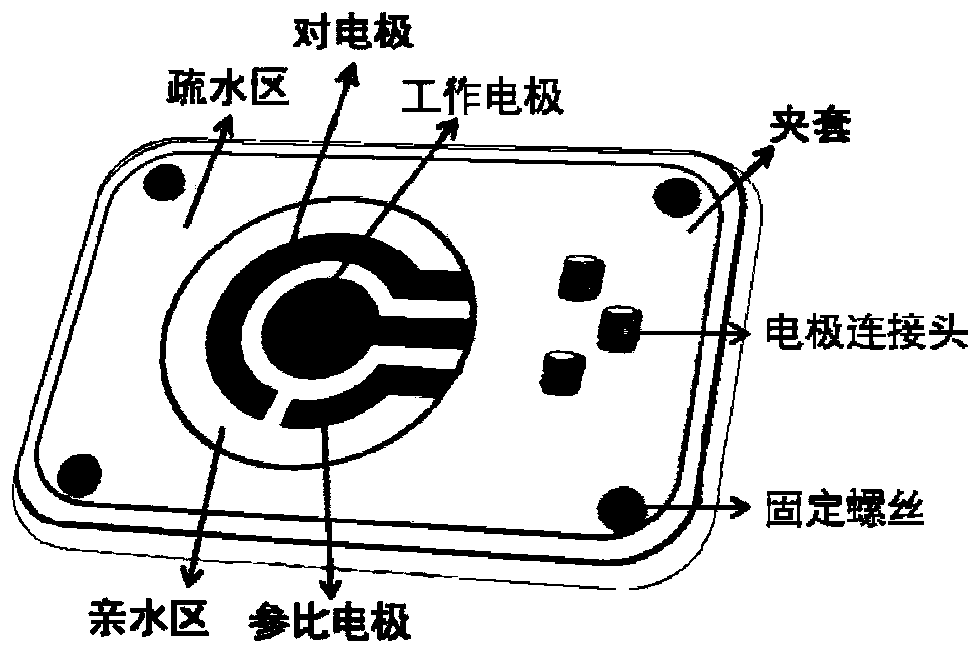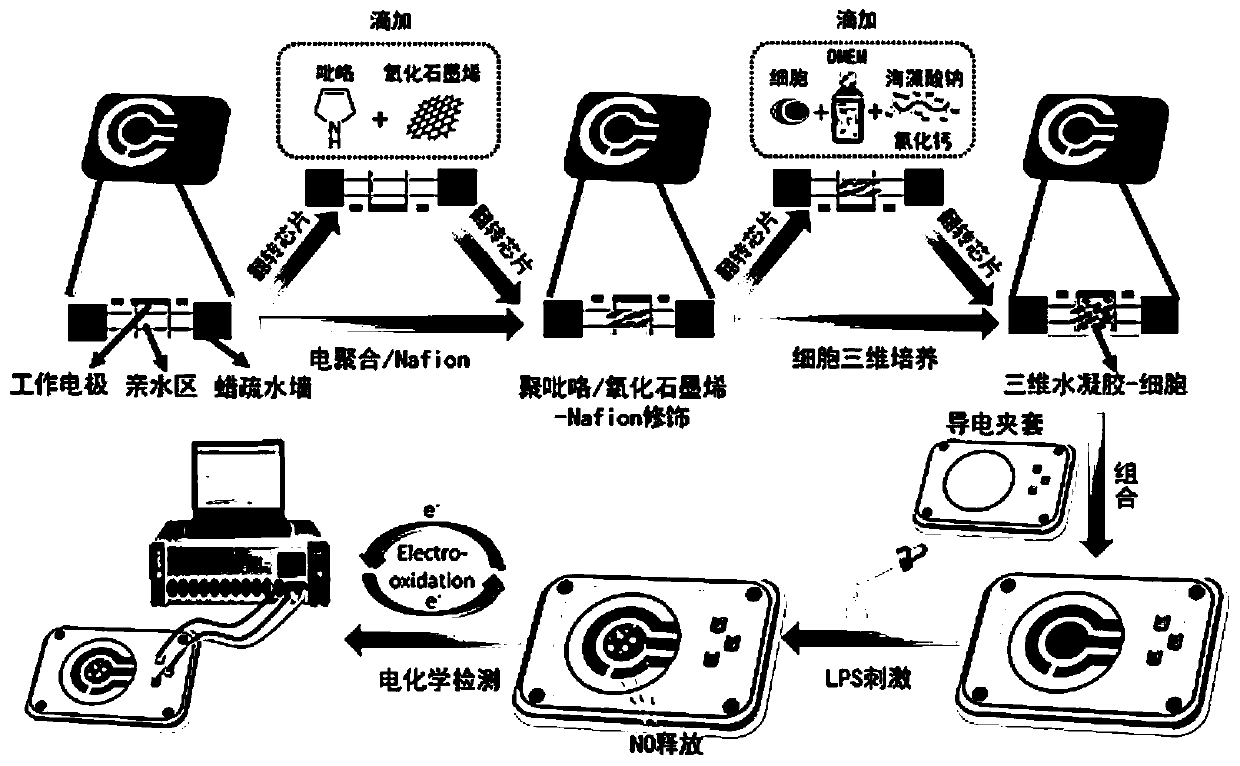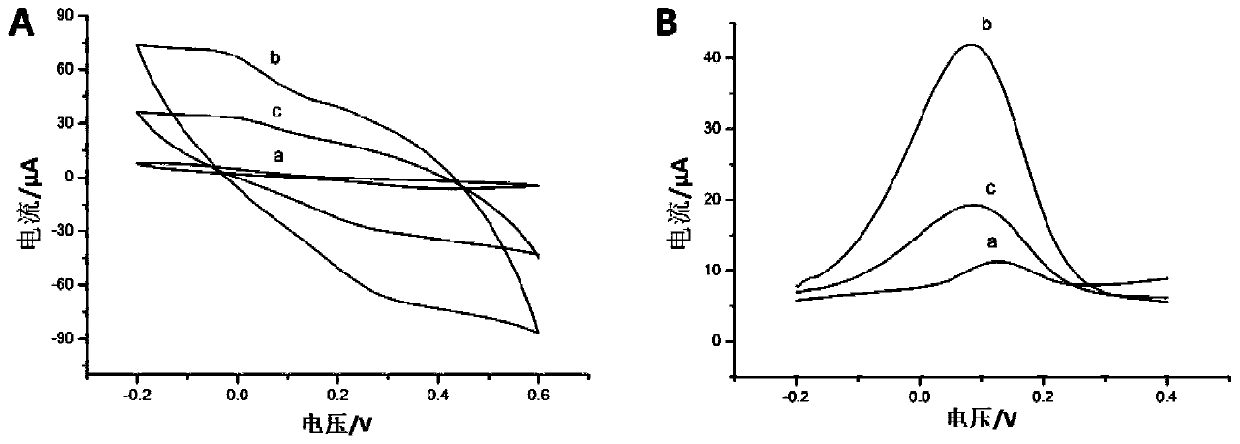Three-dimensional cell paper chip sensor and application thereof in bacterial lipopolysaccharide detection
A three-dimensional cell and paper chip technology, applied in the field of analysis and detection, can solve the problems of repeated use, expensive electrodes, and influence on the accuracy of detection results, and achieve the effect of high sensitivity and low cost
- Summary
- Abstract
- Description
- Claims
- Application Information
AI Technical Summary
Problems solved by technology
Method used
Image
Examples
Embodiment 1
[0049] Example 1: Construction of three-dimensional cell paper chip sensor
[0050] The construction process of the three-dimensional cell paper chip sensor is as follows: figure 2 As shown, the paper chip analysis device is prepared first, the paper chip is turned over, the pyrrole / graphene oxide dispersion is added to the electrode, the paper chip is turned over, the polypyrrole / graphene oxide is electropolymerized, Nafion is added to modify the working electrode, and the working electrode is turned over Paper chip, load the 3D cell culture system to the working electrode, turn over the paper chip, combine the paper chip with the conductive jacket, connect the electrochemical workstation, and construct the 3D cell paper chip sensor.
[0051] 1. Preparation of paper chip analysis device
[0052] Use CorelDRAW software to design hydrophilic / hydrophobic regions and electrode patterns; use a wax printer to print hydrophobic regions on double-circle filter paper, place them in ...
Embodiment 2
[0059] Example 2: Characterization of three-dimensional cell paper chip sensor
[0060]Electrochemical characterization of the constructed three-dimensional cell paper chip sensor. The test conditions of cyclic voltammetry are: the voltage scanning range is -0.2V to 0.6V, the scanning rate is 100mV / s, and the sampling interval is 1mV. The test conditions of differential pulse voltammetry are: the voltage sweep range is -0.2V to 0.6V, the pulse amplitude is 50mV, the pulse width is 50ms, the pulse period is 500ms, and the potential increment is 4mV. Fe(CN) 6 3- / 4- The electrolyte concentration was 2.5mmol / L, and all tests were performed at room temperature.
[0061] exist image 3 In A, curve a is the bare electrode in Fe(CN) 6 3- / 4- The reversible redox peak was obtained by scanning in the solution, and the peak current at this time was 11.12 μA (by image 3 B is calculated from the curve a in the DPV graph); curve b is the reversible redox peak of the polypyrrole / graph...
Embodiment 3
[0063] Example 3: Application of three-dimensional cell paper chip sensor:
[0064] 1. Detection of lipopolysaccharide
[0065] A standard lipopolysaccharide (L7770Sigma-Aldrich) derived from Salmonella Enteritidis was dissolved in PBS to prepare a 1 mg / mL stock solution. Diluted with DMEM medium to a concentration of 10 4 ng / mL, 10 3 ng / mL, 10 2 ng / mL, 50ng / mL, 10ng / mL, 4ng / mL, 3ng / mL, 2ng / mL, 1ng / mL, 0.1ng / mL, 0.01ng / mL lipopolysaccharide solution. Add the lipopolysaccharide solution dropwise to the working area of the three-dimensional cell paper chip sensor to stimulate the cells to be detected.
[0066] 2. Analysis conditions and methods
[0067] Electrochemical detection parameters: Differential pulse voltammetry is adopted, the voltage scanning range is -0.2V~0.5V, the pulse amplitude is 50mV, the pulse width is 50ms, the pulse period is 500ms, the potential increment is 4mV, and the reaction medium is PBS Solution (135mM NaCl, 4.7mM KCl, 10mM NaCl 2 HPO 4 , 2...
PUM
 Login to View More
Login to View More Abstract
Description
Claims
Application Information
 Login to View More
Login to View More - R&D
- Intellectual Property
- Life Sciences
- Materials
- Tech Scout
- Unparalleled Data Quality
- Higher Quality Content
- 60% Fewer Hallucinations
Browse by: Latest US Patents, China's latest patents, Technical Efficacy Thesaurus, Application Domain, Technology Topic, Popular Technical Reports.
© 2025 PatSnap. All rights reserved.Legal|Privacy policy|Modern Slavery Act Transparency Statement|Sitemap|About US| Contact US: help@patsnap.com



